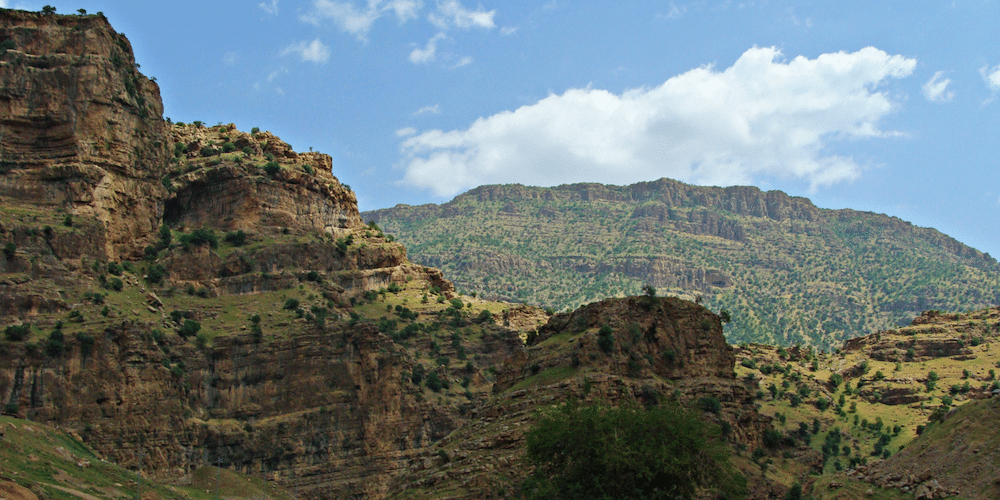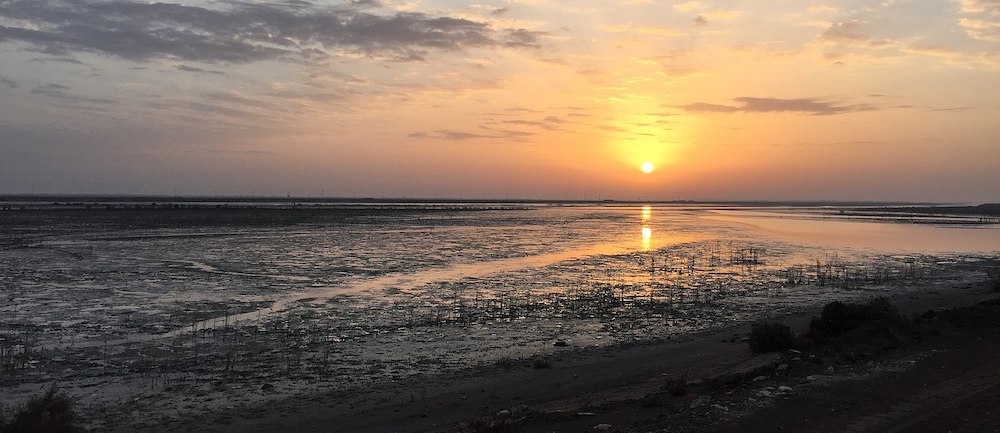Republic of Iraq

Iraq, is a country in Western Asia and in the geopolitical region known as the Middle East. Spanning most of the northwestern end of the Zagros mountain range, the eastern part of the Syrian Desert and the northern part of the Arabian Desert. It shares borders with Kuwait and Saudi Arabia to the south, Jordan to the west, Syria to the northwest, Turkey to the north, and Iran to the east. It has a very narrow section of coastline measuring 58 km (35 miles) at Umm Qasr on the Persian Gulf. Iraq is comparable in size to the US state of California, and somewhat larger than Paraguay. It has a population of about 46.5 million people. The capital and largest city is Baghdad with a population of around eight million people, followed by Mosul, Basra, Kirkuk and Erbil.
There are two major rivers: the Tigris and the Euphrates. These provide Iraq with agriculturally capable land and contrast with the desert landscape that covers most of Western Asia and around 40% of Iraq. Iraq mainly consists of desert, but between the two major rivers the area is fertile, the rivers carrying about 60 million cubic of silt annually to the delta. The north of the country is mostly composed of mountains covering 30% of the country; the highest point being at 11,847 ft point, unnamed on maps, but known locally as Cheekah Dar (black tent). Close to the coast and along the Shatt al-Arab there used to be marshlands, but many were drained in the 1990s.
The local climate is hot and arid with a subtropical influence so is mostly desert, with mild to cool winters and dry, hot, cloudless summers. The northern mountainous regions (Kurdistan region) have cold winters with occasional heavy snows, sometimes causing extensive flooding.

Zagros Mountains – kyselak CC BY-SA 4.0 via Wikimedia Commons
Birding Iraq
Iraq has multiple and diverse biomes which include the mountainous region in the north to the wet marshlands along the Euphrates and Tigris rivers, while western part of the country comprises mainly desert and some semi-arid regions. Draining of the Mesopotamian Marshes, by Saddam’s regime, caused there to be a significant drop in biological life. Since the overthrow, flow is restored and the ecosystem has begun to recover. Iraqi corals are some of the most extreme heat-tolerant as the seawater in this area ranges between 14 and 34 °C. Aquatic or semi-aquatic wildlife occurs in and around these, the major lakes are Lake Habbaniyah, Lake Milh, Lake Qadisiyah and Lake Tharthar.
The avifauna of Iraq include a total of 421 species, of which two have been introduced by humans. 20 species are globally threatened. Many of Iraq’s bird species were endangered, 12 of its bird species as well as seven of Iraq’s mammal species were at critical risk. The Mesopotamian marches in the middle and south are home to approximately 50 species of birds, and rare species of fish. At risk are some 50% of the world’s marbled teal population that live in the marshes, along with 60% of the world’s population of Basra reed-warbler.

Basra Marshes – ©Saajjoo, CC BY-SA 4.0 via Wikimedia Commons
During the first decade of the 21st century surveys to identify the key biodiversity areas undertaken by the newly established NGO Nature Iraq, established fifty breeding species formerly not known bring the total number breeding to 190. The comprehensively covered Iraqi Kurdistan, the arid rangelands of western and central Iraq and the southern marshes.
-
Wikipedia
GNU Free Documentation License
https://en.wikipedia.org/wiki/Iraq
-
Number of bird species: 421
(As at June 2024)
-
Avibase
PDF ChecklistThis checklist includes all bird species found in Iraq , based on the best information available at this time. It is based on a wide variety of sources that I collated over many years. I am pleased to offer these checklists as a service to birdwatchers. If you find any error, please do not hesitate to report them. -
OSME
PDF Annotated ChecklistThis checklist summarises the status of birds recorded in Iraq up to January 2012. It is based on an extensive review of the ornithological literature, the results of seven years of surveys throughout the country by Nature Iraq and comments received following the publication of our provisional checklist (Porter et al 2010). A further stimulus for the preparation of this checklist was the publication of a field guide to the birds of Iraq in Arabic (Salim et al 2006) -
Wikipedia
Annotated ListThis is a list of the bird species recorded in Iraq. The avifauna of Iraq include a total of 421 species, of which two have been introduced by humans. 20 species are globally threatened. -
eBird
PDF ChecklistThis checklist is generated with data from eBird (ebird.org), a global database of bird sightings from birders like you. If you enjoy this checklist, please consider contributing your sightings to eBird. It is 100% free to take part, and your observations will help support birders, researchers, and conservationists worldwide.
-
Birding Babylon: A Soldier's Journal from Iraq
| By Jonathan Trouern-Trend | Sierra Club Books | 2006 | Hardback | 79 pages, no illustrations | Ot of Print | ISBN: 9781578051311 Buy this book from NHBS.com -
Birds of the Middle East
| By Richard Porter, Simon Aspinall, A Birch, John Gale, Mike Langman, Brian E Small | Helm | 2024 | Edition 3 | 400 pages, 180 colour plates, 636 colour distribution maps | ISBN: 9781399401968 Buy this book from NHBS.com -
Key Biodiversity Areas of Iraq
| Priority Sites for Conservation & Protection | By Nature Iraq | Tablet House Publishing | 2017 | Hardback | 297 pages, colour photos, 8 colour illustrations, 24 colour maps, 24 colour tables | ISBN: 9780988651463 Buy this book from NHBS.com -
The Ghosts of Iraq's Marshes
| A History of Conflict, Tragedy, and Restoration | By Steve Lonergan, Jassim Al-Asadi & Keith Holmes | American University in Cairo Press | 2024 | Hardback | 274 pages, 6 b/w maps | ISBN: 9781649033253 Buy this book from NHBS.com
-
BirdLife
WebsiteWe go beyond today to impact the future. Through sharing local challenges the BirdLife Partnership find lasting global solutions. -
Nature Iraq
WebsiteNature Iraq is an Iraqi non-governmental organization registered in Iraq, accredited to the United Nations Environment Programme (UNEP) and Iraq’s first and only Affiliate to Birdlife International . We work to protect, restore, and preserve Iraq’s natural environment and the rich cultural heritage it nourishes… -
Ornithological Society Of The Middle East The Caucasus And Central Asia
WebsiteIraq sits between the three continents of Africa, Europe and Asia, and this makes the country especially important for the many migratory species that pass through. In addition, there is a wide variety of habitat types (including ten ecoregions), and this results in a rich avifauna.
-
*Protected areas of Iraq
InformationSatellite ViewUncludes RAMSAR sites and parks -
Iraq - Convention on Biological Diversity
PDF ArticleSatellite ViewAction Plan for Implementing the Programme of Work on Protected Areas of the Convention on Biological Diversity -
NP Halgurd Sakran
InformationSatellite ViewHSNP will be the largest protected mountain area in Kurdistan; it is expected to cover more than 1100 km2 with a height of 900 m up to 3,609 m at Halgurd Peak, known as the Sakran Mountain Range as a part of the Zagros Mountains, which is famous for the spectacular and impressive rock formation, beautiful valleys and mountain meadows with multitude of wild flora and fauna. -
NR Mosul Lake
PDF ArticleSatellite ViewThis site consists of a large freshwater lake reservoir created by the Mosul Dam southwest of Dohuk city.

